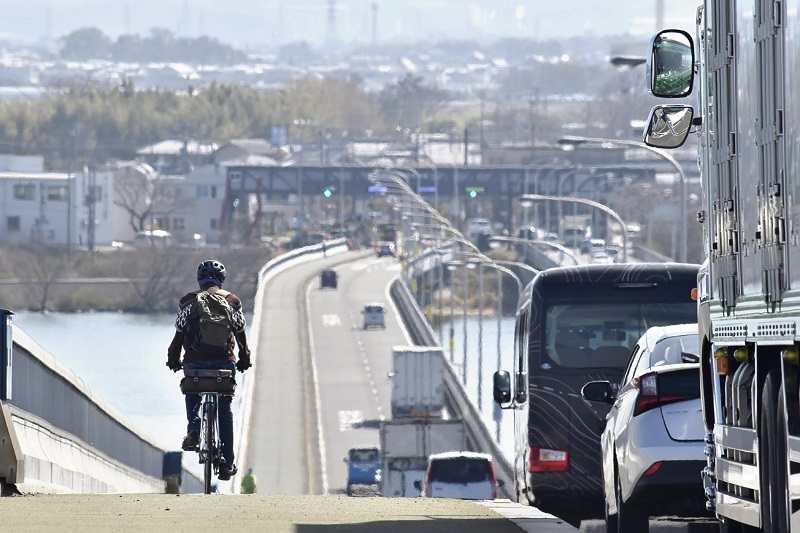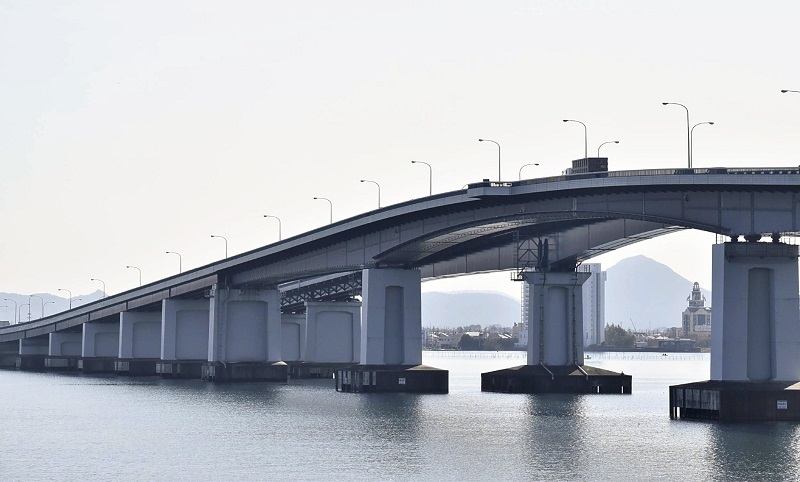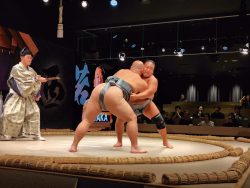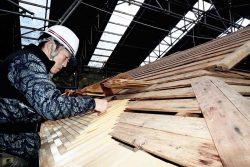
A cyclist passes the Biwako Ohashi bridge in Otsu.
21:28 JST, April 24, 2021
OTSU — Cyclists have been turning their handlebars toward the Biwako Ohashi bridge, which spans a narrow strait at the southern part of Lake Biwa, Japan’s largest body of freshwater.
Cyclists can access the toll bridge free of charge. In recent years, more and more people have become inclined to get their bikes and pedal across the bridge, which is between Otsu and Moriyama in Shiga Prefecture.

Biwako Ohashi is seen from the lakeshore of Otsu.
The Biwako Ohashi “bridge” is actually two bridges. The newer 1.4-kilometer bridge has an observatory at its apex, which is 26.3 meters above the lake’s surface. Many cyclists stop at the observatory to enjoy picturesque panoramas of the Hira mountains and the Ukimido floating temple hall. When the weather is clear, distant Chikubu Island can be seen in the northern part of the lake along with Mt. Ibuki to its east.
Built during a period when the nation was experiencing rapid economic growth, the original bridge was completed in time for the opening of the 1964 Tokyo Summer Olympics. At that time, it was the longest bridge in the nation.
More than half a century later, the bridge continues to serve as a major artery supporting logistics, tourism and the daily lives of Shiga Prefecture’s residents.
When the bridge first opened, about 2,000 vehicles traveled across it per day, but the traffic volume later ballooned drastically. A sidewalk was installed in 1980 as an additional safety measure, but at only 1.5 meters wide, it was considered too narrow by many.
In 1994, a parallel two-lane bridge on the north side was opened to help relieve the problematic traffic congestion that had built up over the years. The new bridge also came with a 3-meter-wide sidewalk, which has drawn increasing number of cyclists as it allows them to ride more safely.
Biwaichi’s unofficial leg
The 200-kilometer cycling route encircling Lake Biwa, dubbed “Biwaichi,” has recently gained nationwide popularity. In 2019, the central government designated it as a National Cycle Route and one of the country’s leading routes for bicycle tourism.
Although the Biwako Ohashi bridge is not officially included as a leg on the course, it is nevertheless often used by cyclists either as a shortcut instead of the encircling route or as a way to only cycle around the southern part of the lake or the northern part.
“The spring sunshine feels great,” said a 21-year-old college student from Kyoto, wiping sweat from his brow. It was mid-March and he had just cycled across the bridge.
He was on a cycling journey with a friend circling the south side of the lake. He said the past year had sent his stress levels through the roof because of the coronavirus pandemic and only being able to join classes online.
“This is the best way to get out and get some air,” he said.
This year, Biwako Ohashi bridge will be featured as part of the torch relay for the upcoming Tokyo Games. Starting from the Otsu side on May 27, a mounted cyclist is slated to hold the torch and cycle across a section of the Biwako Ohashi bridge. The torch will then make its way through Moriyama.
The idea was proposed to the Tokyo Organizing Committee of the Olympic and Paralympic Games by Shiga prefectural and municipal governments as part of efforts to promote Biwaichi.
“The presence of a bridge allows for a variety of ways to get around the lake. The bridge is an indispensable part of Biwaichi,” said a prefectural government official in charge of promoting Biwaichi.
Bridge of dreams
The bridge was built in part with the aim of closing a prosperity gap that had been expanding between the lake’s western and eastern regions. Areas west of the lake had been experiencing a development boom, but without ease of access to the same resources, those living east of the lake were increasingly being left behind.
Construction work proceeded day and night to complete the project in time for the October start date of the 1964 Tokyo Olympics. And in September that year, the bridge opened — less than two years after the work began.
The first bridge, which is 1.35 kilometers long, has two lanes bound for Otsu, while the newer bridge has two lanes bound for Moriyama. The speed limit for automobiles is 60 kph. The toll is ¥150 for standard automobiles and ¥10 for motorcycles and others. Passage for cyclists and pedestrians is free.

A map of Biwako Ohashi bridge / Shiga Prefecture
Related Tags
"Features" POPULAR ARTICLE
-

Students Recreate 19th-Century Bento Boxes Made for Ino Tadataka’s Survey Team in Hot Spring Town on Nakasendo Road
-

Santa Claus Delivers Christmas Presents to Penguins at Aquarium in Japan’s Nagasaki Prefecture
-

Sumo Restaurant in Tokyo Teaches Foreign Visitors About the Ancient Sport, with Bouts Between Retired Rikishi
-

Autonomous Passenger Ship Connects Mainland with Remote Island in Seto Inland Sea; World’s 1st Commercially Operated Autonomous Vessel
-

Osaka’s Sumiyoshi Taisha Shrine Bustles with New Year’s Visitors
JN ACCESS RANKING
-

As Chinese Tourists Shun Japan, Hotels and Stores Suffer
-

Osaka-Kansai Expo’s Economic Impact Estimated at ¥3.6 Trillion, Takes Actual Visitor Numbers into Account
-

Japan Govt Adopts Measures to Curb Mega Solar Power Plant Projects Amid Environmental Concerns
-

BOJ Gov. Ueda: Highly Likely Mechanism for Rising Wages, Prices Will Be Maintained
-

Economic Security Panels Debate Supply Chains, Rare Earths; Participants Emphasize Importance of Cooperation Among Allies




























